The ketogenic, or keto, diet emphasizes eating high-fat, low-carb foods to prompt the body into a state of ketosis, where it burns fat for fuel instead of carbohydrates. This shift in metabolism can serve as a strategy for weight loss and has spawned a wide variety of keto-friendly foods, including snacks tailored to comply with the stringent carb restrictions of the diet. Snacks can be an integral part of a keto diet, helping to stave off hunger between meals without compromising ketosis.
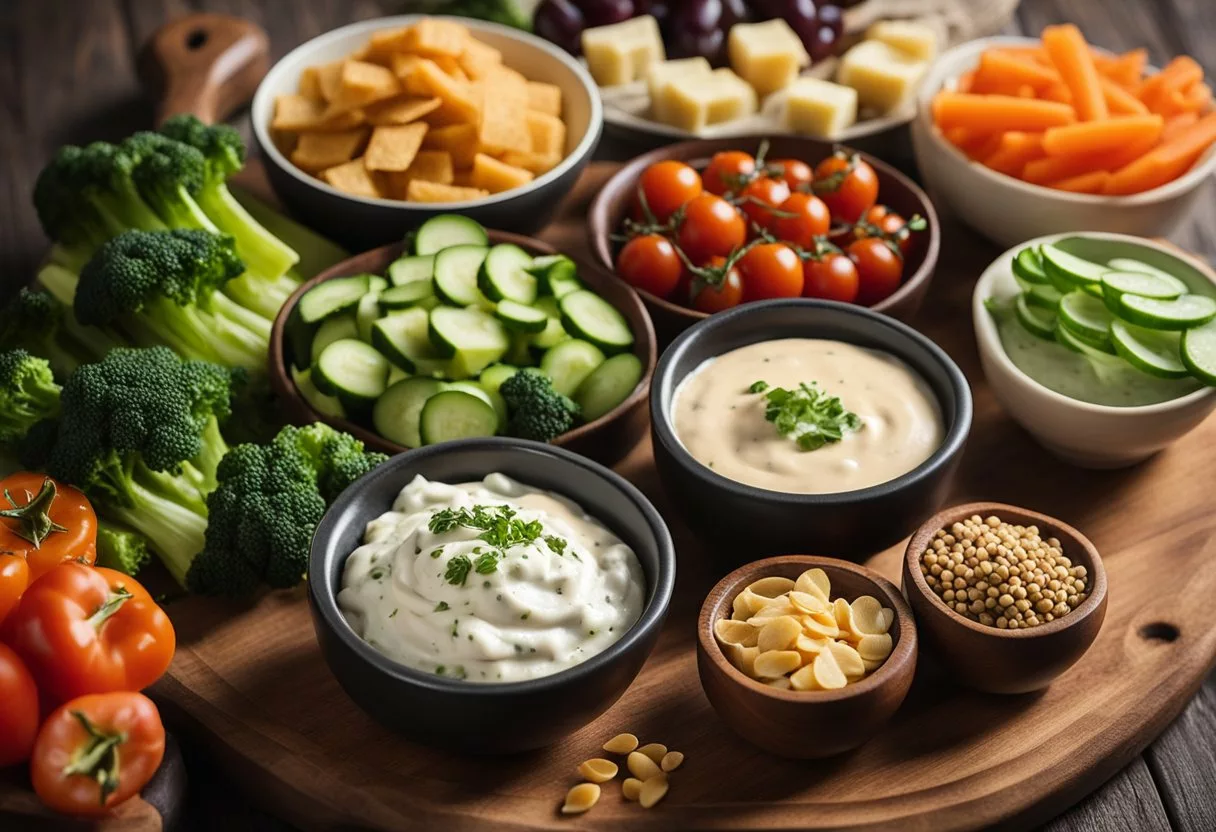
For those adhering to a keto lifestyle, the challenge often lies in finding quick and easy snacks that satisfy cravings without breaking the carb bank. Keto snacks come in many forms, from those you can prepare with minimal effort at home to ready-made options available for purchase. In selecting keto snacks, it’s essential to look for ingredients that align with the dietary principles of keto—high in healthy fats, and moderate in protein, while being ultra-low in carbohydrates.
Key Takeaways
- Keto snacks adhere to low-carb, high-fat dietary needs and aid in managing hunger while on a keto diet.
- Convenience and simplicity in snack preparation are important for maintaining a keto lifestyle.
- Incorporating a variety of keto snacks helps prevent dietary monotony and supports sustained adherence to the diet plan.
Understanding Keto Snacks
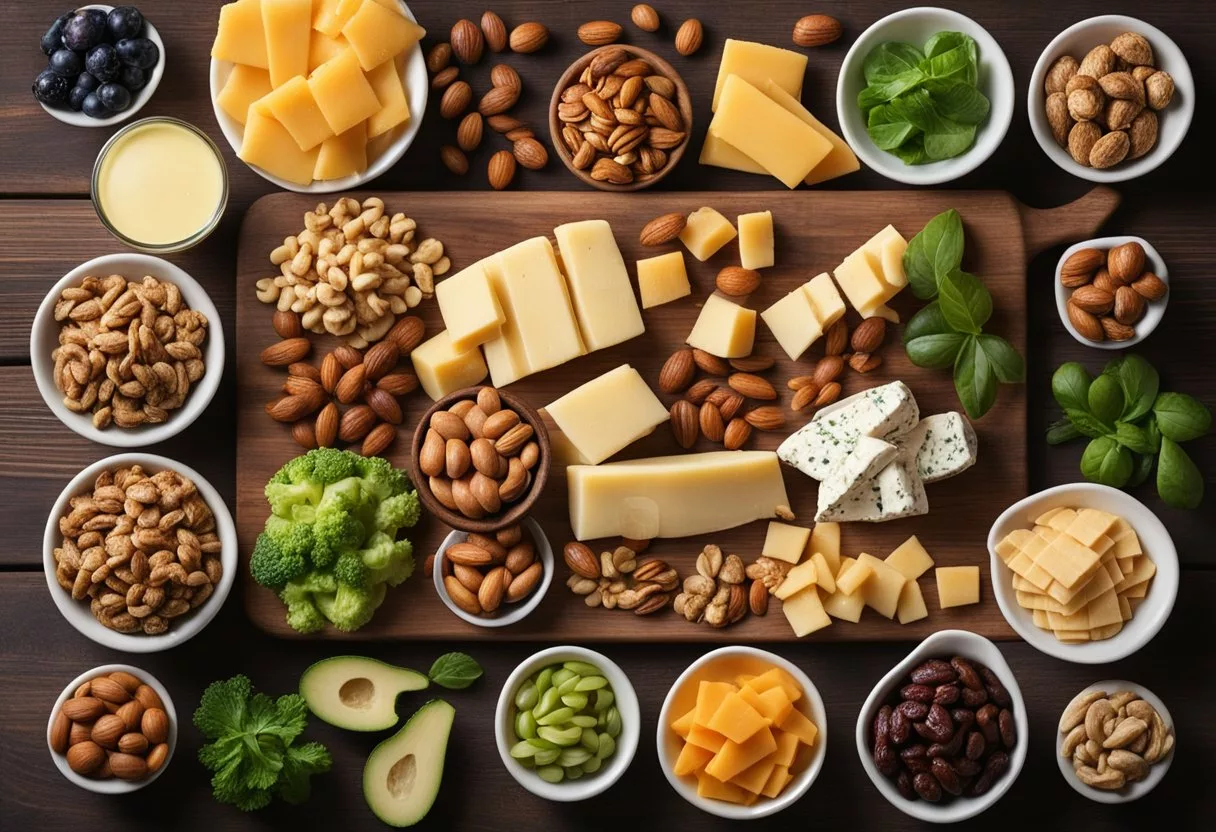
Keto snacks are an integral part of maintaining a ketogenic diet, focusing on high-fat, moderate protein, and low carbohydrate intake to sustain ketosis. They contribute to the overall macronutrient balance and can be both satisfying and nutritious.
The Keto Diet and Snack Relevance
On the ketogenic diet, an individual reduces their carbohydrate consumption significantly, usually to below 50 grams of net carbs per day, to promote a state called ketosis. Ketosis is a metabolic state where the body burns fat for fuel instead of carbohydrates. Keto snacks are valuable because they provide a convenient way to keep energy levels steady and curb hunger between meals without exceeding the low carb threshold. These snacks typically have a high fat content, moderate protein, and are low in net carbs—the total carbs minus fiber.
Benefits of Keto-Friendly Snacking
Keto-friendly snacking supports weight management by preventing overeating during meals and maintaining steady blood sugar levels. Many keto snacks are rich in healthy fats and fiber, which provide satiety and a slower release of energy. The inclusion of moderate amounts of protein helps in preserving muscle mass, especially important during weight loss. Snacking within the keto parameters ensures that individuals can continue to enjoy food throughout the day while still staying on track with their dietary goals.
Macronutrient Profile of Keto Snacks
A proper keto snack has a specific macronutrient ratio that aligns with the ketogenic diet’s requirements:
- High in Fat: Usually forms the largest portion of the snack’s calories.
- Moderate in Protein: Enough to support muscle health but not so high that it can be converted into glucose.
- Low in Net Carbs: To maintain ketosis, it’s crucial that snacks are low in net carbs.
For example, a 100-gram serving of avocado contains approximately 2 grams of net carbs and is high in both healthy fats and fiber. Here is a basic guideline for understanding the macronutrient breakdown:
| Nutrient | Role in Keto Snacks | Ideal Intake |
|---|---|---|
| Fat | Primary energy source | High |
| Protein | Muscle maintenance | Moderate |
| Net Carbs | Minimized to sustain ketosis | Low |
| Fiber | Support digestion, subtracted from total carbs in net carb calculation | Varied |
Keto snacks can range from whole foods like olives and cheese to processed options like pepperoni slices or packaged keto bars. The goal is to choose snacks that support the metabolic state of ketosis while also providing nutritional value.
Categories of Keto Snacks
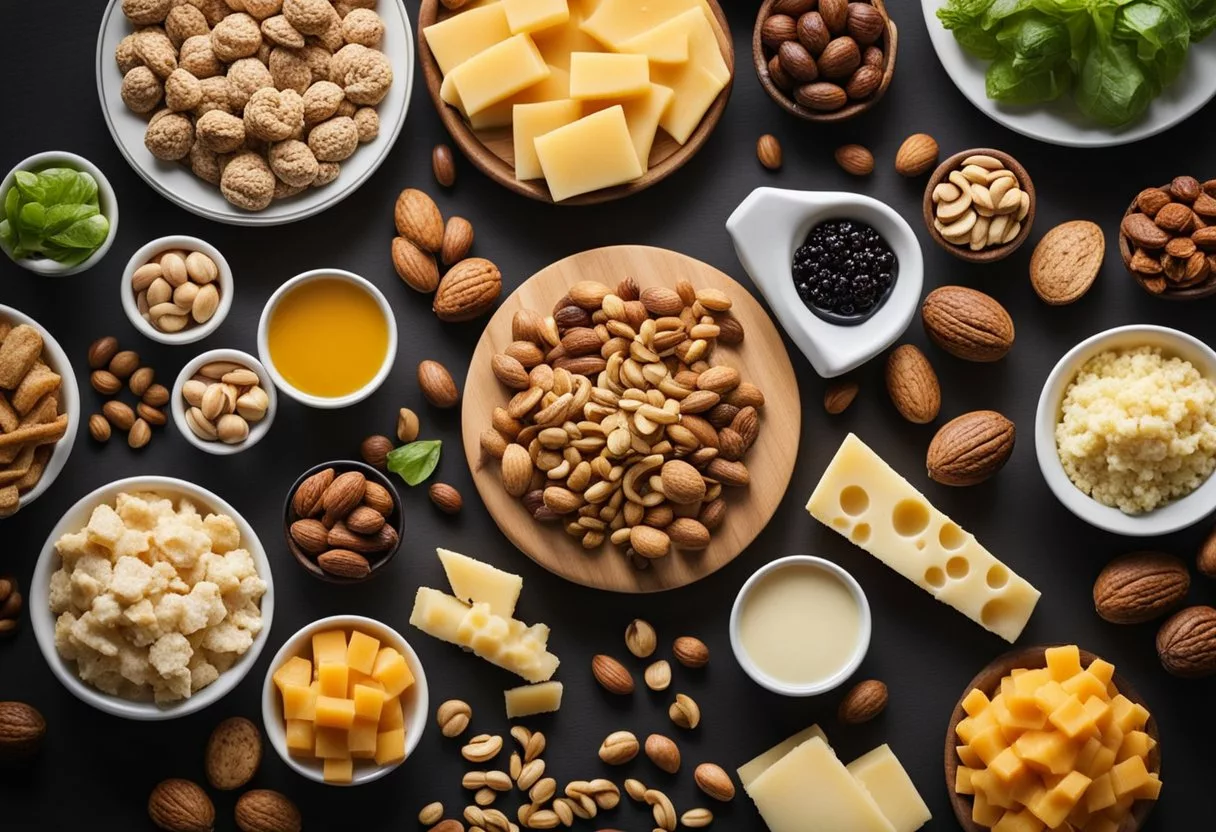
Selecting keto snacks requires knowing the kinds available. They can generally be categorized by taste preference, the convenience of preparation, and their role in your dietary routine.
Sweet Vs. Savory Keto Snacks
Keto snacks satisfy a range of taste buds by dividing into sweet and savory options. Sweet keto snacks might include whipped cream cheese with vanilla and berries for a low-carb treat, while savory alternatives such as bacon-wrapped asparagus offer a fulfilling bite without the carbs.
Homemade Vs. Store-Bought Options
Keto snackers can choose between homemade and store-bought. Homemade keto snacks ensure control over ingredients and nutrition; recipes such as lemon pepper baked wings and broccoli cheddar frittata fit this category. Conversely, store-bought snacks offer convenience and include items like sliced pepperoni or packaged low-carb nuts.
Quick Snacks Vs. Meal Preps
Finally, keto snacks differ in preparation time. Quick snacks require minimal to no preparation, like cheese slices or nuts, perfect for snacking on the go. Meal preps involve snacks designed for readiness and convenience, with examples including pre-made egg muffins or parmesan zucchini fries that are ready after a brief reheating.
Popular Keto Snack Ingredients
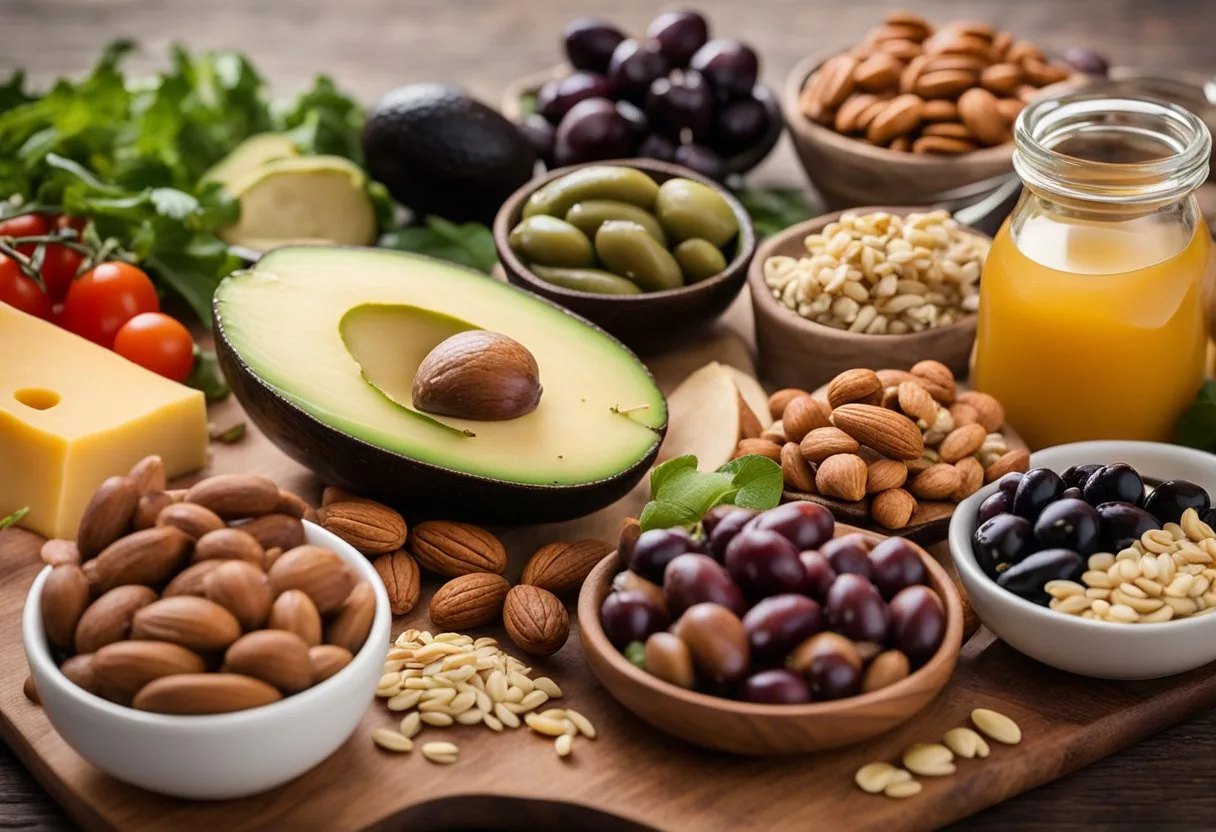
Choosing the right ingredients is essential for creating keto-friendly snacks that are both delicious and adherent to the low-carbohydrate requirements of the ketogenic diet. These key ingredients often serve as the building blocks to a wide variety of keto snack options.
Nuts and Seeds
Nuts and seeds are a staple in the keto snacking pantry due to their high healthy fat content and low net carb levels. Popular choices include:
- Almonds: Ideal for snacking or almond butter.
- Walnuts and Macadamia: Known for their healthy fats.
- Pecans: Often used in sweet keto treats due to their buttery flavor.
- Seeds: Such as pumpkin and chia seeds, offer crunch and nutrition.
Dairy Products
Dairy is prized in keto snacks for its fat content and protein. Key dairy products include:
- Cheese: Varieties like cheddar, mozzarella, and cream cheese are keto favorites.
- Butter: Adds richness to fat bombs and other keto creations.
- Cream Cheese: Perfect for dips or as a creamy snack base.
Meat and Seafood
Protein-rich meats and seafood are excellent for satiety on a keto diet:
- Bacon: Often used for added flavor and satisfying crunch.
- Beef Jerky and Deli Meats: Convenient for on-the-go snacking; opt for low-sugar options.
- Tuna Salad and Roast Beef: Make flavorful filling for lettuce wraps or keto sandwiches.
Vegetables and Fruits
Low-carb vegetables and fruits can add variety and essential nutrients:
- Avocado: A versatile source of healthy fats.
- Tomatoes: Pair well with cheese or cold cuts.
- Zucchini Chips: Serve as a low-carb alternative to conventional chips.
- Berries: Like strawberries and blueberries, are enjoyed in moderation for sweetness.
Sweeteners and Flavorings
To satisfy the sweet tooth without added sugars, these options are often included:
- Stevia and Erythritol: Commonly used natural sweeteners in keto treats.
- Dark Chocolate: (with high cocoa content) for a rich flavor.
- Vanilla and Cocoa: Add depth of flavor to sweet keto snacks like fat bombs.
- Coconut Oil: Often incorporated for its healthy fats and subtle sweetness.
Recipe Ideas and Preparation Tips
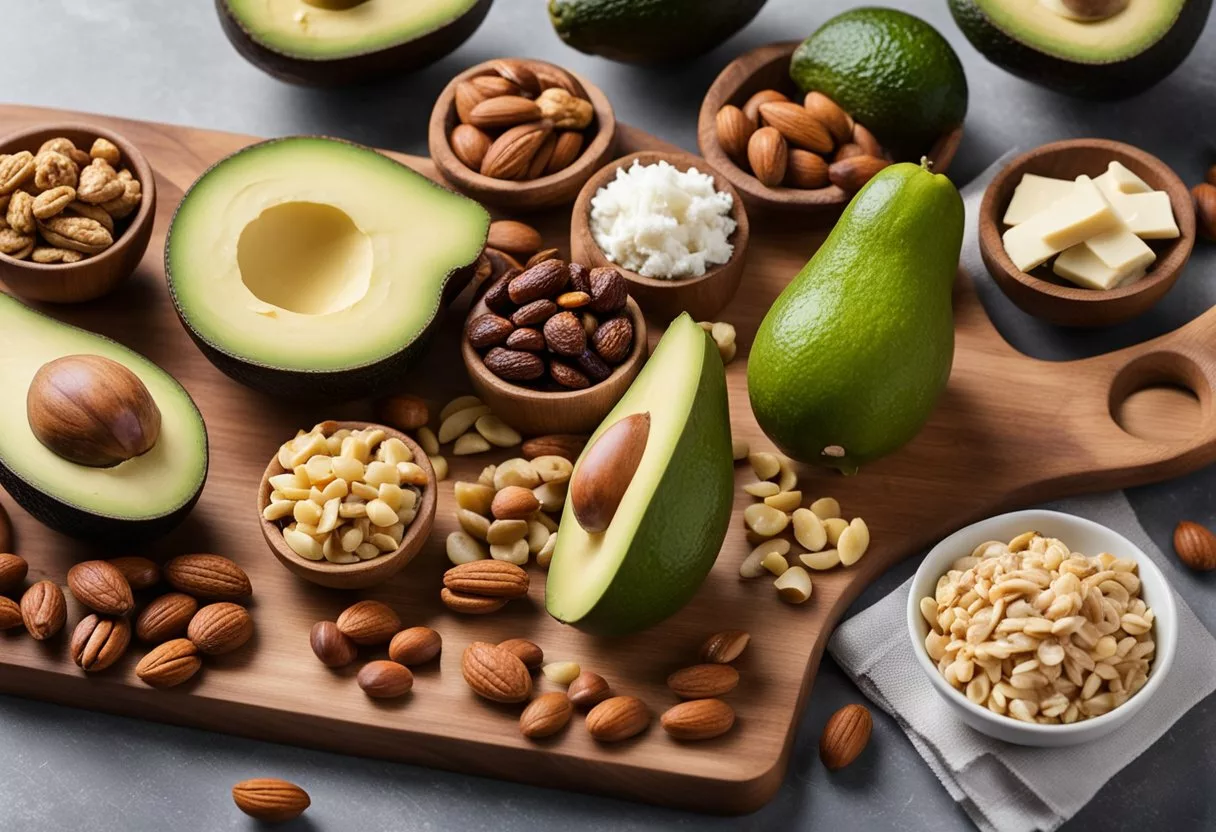
This section provides a curated selection of keto snack recipes that cater to sweet tooth cravings and savory preferences, as well as tips for air-frying and snacking on the go.
Keto-Friendly Sweet Snacks
When it comes to sweets on a ketogenic diet, natural sweeteners and low-carb ingredients are key. Keto mug cakes or chocolate fat bombs provide a quick fix for dessert cravings. Fat bombs are often made with coconut oil, cocoa powder, and a keto-friendly sweetener, allowing them to maintain low net carbs while satisfying sweetness.
Keto Chocolate Peanut Butter Smoothie:
- Combine 2 tbsp of unsweetened peanut butter, 1 tbsp cocoa powder, a handful of ice, and a cup of unsweetened almond milk.
- Sweeten with stevia or erythritol to taste. Blend until smooth.
Savory Snack Recipes
Savory snacks are incredibly diverse on a keto diet. From cheese crisps made by baking small piles of shredded cheese until crispy, to deviled eggs filled with a creamy mixture of the yolk, mayonnaise, and spices, options are plentiful.
- Caprese Salad Skewers: Alternate fresh mozzarella balls, cherry tomatoes, and basil leaves on skewers. Drizzle with balsamic reduction.
- BLT Lettuce Wraps: Use crisp lettuce leaves to wrap cooked bacon, a slice of tomato, and a spread of mayonnaise.
Snacks Using An Air Fryer
The air fryer is an excellent tool for preparing quick and crispy keto snacks. Foods like Parmesan zucchini fries and pork rinds can be cooked to perfection with minimal oil. Air frying can create snacks with the crunch one often misses on a keto diet.
Air Fried Cheese Crisps:
- Place small heaps of cheese in the air fryer basket.
- Cook at 370°F (187°C) until golden brown, usually about 4-6 minutes.
Parmesan Zucchini Fries:
- Cut zucchini into fry-shapes, coat with grated Parmesan and almond flour.
- Air fry until crispy, typically 10-12 minutes at 400°F (200°C).
On-The-Go and Quick Fixes
For keto dieters needing a snack without the time for prep, consider items like hard-boiled eggs, pork rinds, or keto crackers. They are satisfying and easy to transport, providing a quick solution for hunger pangs.
- Keto Crackers: Look for brands that use almond flour or seed mixtures without added sugars.
- Baked Cheese Crisps: Pre-made cheese crisps are a convenient, crunchy option suitable for keto snacking.
Egg Muffins:
- Whisk eggs with salt, pepper, and a choice of low-carb vegetables or meats.
- Bake in a muffin tin until set, offering an easy, portable breakfast or snack.
Storing and Portioning for Keto Snacks
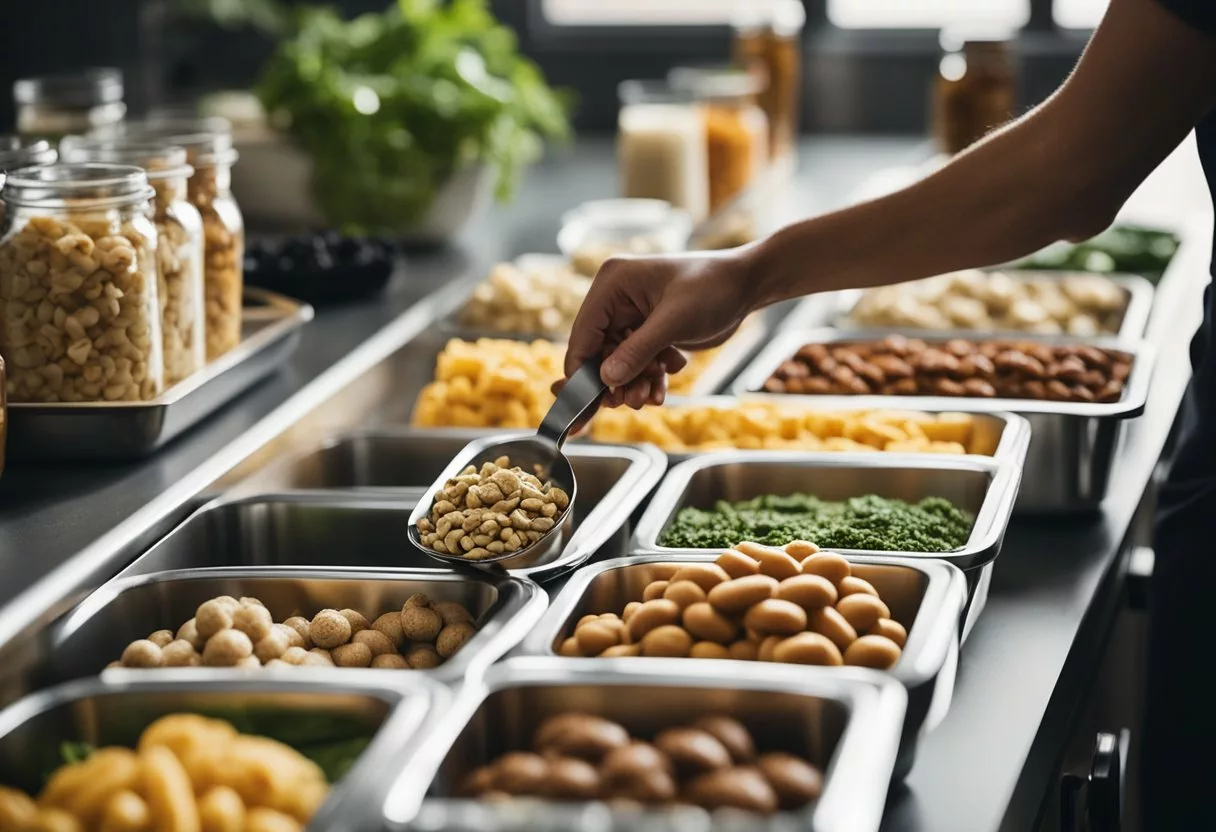
Proper storage and accurate portioning of keto snacks are critical for maintaining their freshness and ensuring the diet’s effectiveness by tracking net carbs.
Shelf Life and Preservation
For keto snacks that are high in fat, like those containing coconut oil or fresh herbs, appropriate storage is essential to prevent spoilage. An individual should store snacks in airtight containers and, when necessary, refrigerate to extend shelf life. Snacks like hard-boiled eggs or high-fat cheeses should always be refrigerated and consumed within a week. Here’s a brief guideline:
- Nuts and Seeds: Store in a cool, dry place; they last up to 3 months.
- Cheese: Refrigerate; typically lasts 1-4 weeks, depending on the type.
- Cold Cuts: Refrigerate; consume within 5-7 days.
Measuring and Tracking Snack Intake
Accurate measurement of snack intake is crucial for keeping within the daily limit of net carbs. One must portion their snacks correctly, focusing on the net carb content, which is the total carbs minus fiber. Using kitchen scales or measuring cups ensures precise servings. For instance, a person might measure out:
- Nuts: A handful (about 1 ounce or 28 grams)
- Cheese: A small slice (around 1 ounce)
- Vegetables: 1 cup raw or 1/2 cup cooked
Keeping track of these amounts allows individuals to make informed choices about their snack intake, ensuring they adhere to the low-carb framework of the ketogenic diet.
Incorporating Snacks Into a Keto Diet Plan
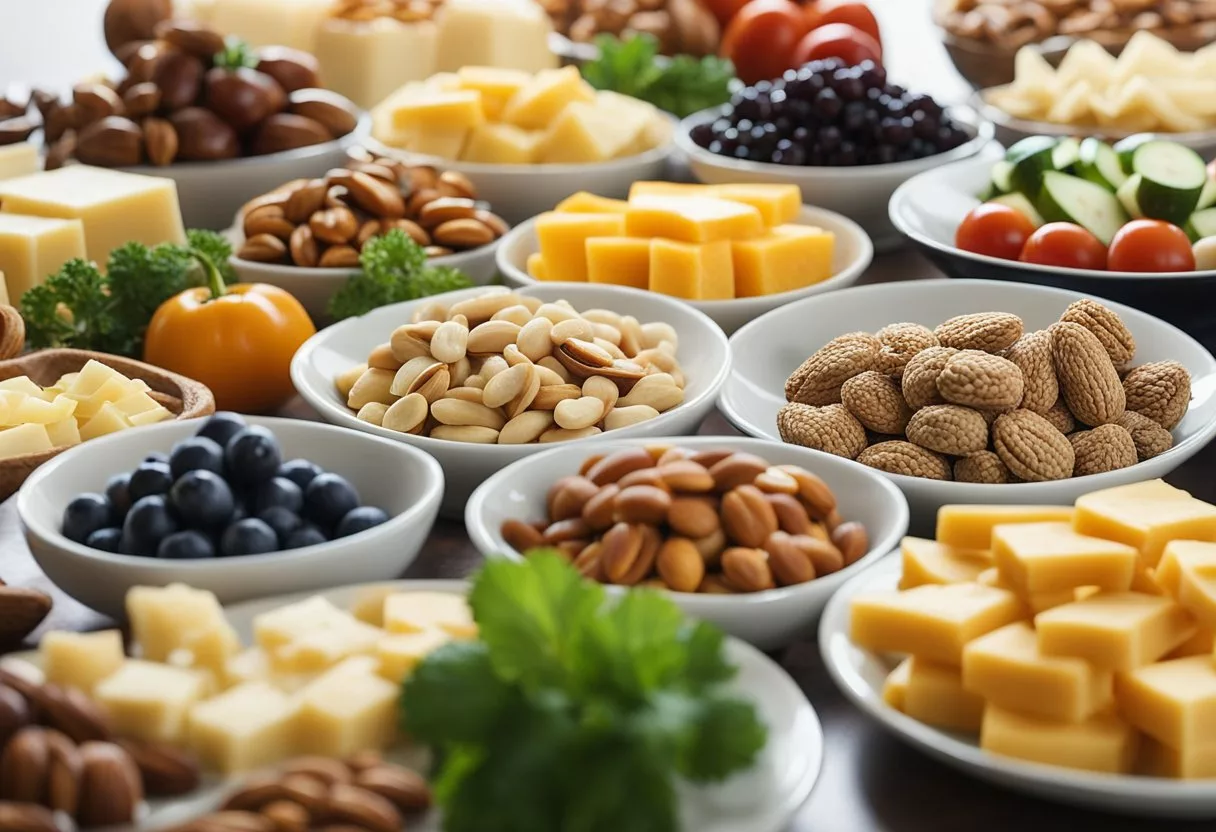
Snacking on a ketogenic diet can be beneficial for maintaining energy levels and keeping hunger at bay between meals. It is crucial to choose snacks that align with ketosis goals and macro balance.
Balancing Meals and Snacks
When following a ketogenic diet, individuals should ensure that their snacks are high in healthy fats and low in carbohydrates to maintain the metabolic state of ketosis necessary for weight loss. A person needs to consider their daily macronutrient targets and choose snacks that contribute to these goals without exceeding carb limits. Meal prep is an effective strategy to balance out snacks with regular meals. By preparing keto-friendly snacks in advance, individuals are less likely to deviate from their diet plan when they need a quick bite.
Example of a Balanced Keto Snack:
| Snack Choices | Carb Content | Fat Content |
|---|---|---|
| Sliced Avocado | Low | High in fat |
| Cheese Cubes | Low | High in fat |
| Boiled Eggs | Trace carbs | Moderate fat |
Strategic Snacking for Ketosis
Strategic snacking is key to supporting a ketogenic lifestyle. Snacking should not be an impulsive decision but a planned part of the diet. Consuming snacks with the right proportion of fats can aid in staying in ketosis. This technique helps in ensuring constant energy levels and may assist with weight loss by preventing overeating during main meals such as dinner. Snacks like cold cuts, cheese, and low-carb vegetables dipped in high-fat sauces make for perfect keto-friendly choices.
Ideal Keto Snack Options:
- Meats: Turkey, salami, or ham slices with no added sugar
- Dairy: Full-fat cheese or cream cheese
- Vegetables: Celery or cucumber with guacamole or ranch dressing
- Nuts: Almonds or macadamia nuts (in moderation due to calories)
Incorporating appropriate snacks into a keto diet plan involves careful consideration of nutritional content and timing to support ketosis and weight management goals.
Alternative and Novel Snack Ideas
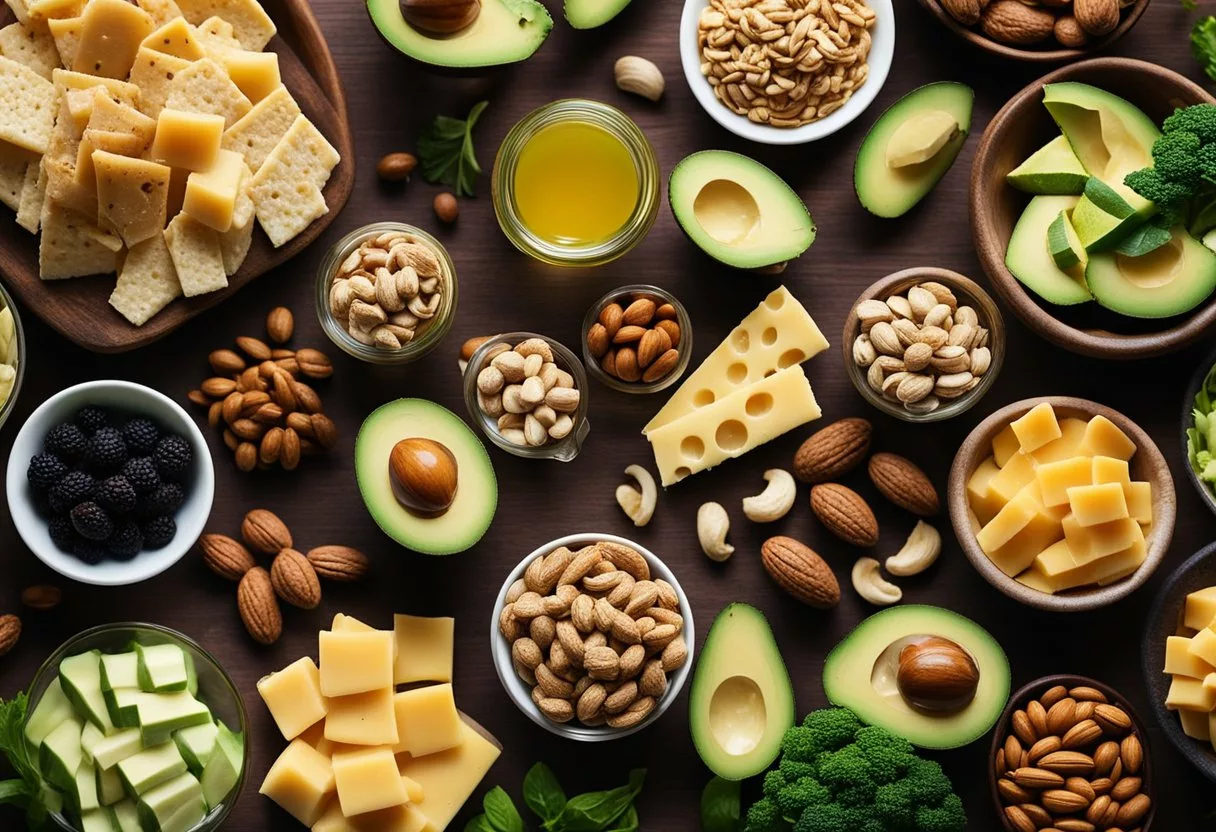
When following a ketogenic diet, it is crucial to find snacks that align with the diet’s low-carb, high-fat principles. This section presents creative options for those with specific dietary preferences or restrictions.
Dairy-Free and Nut-Free Options
For individuals avoiding dairy and nuts, seeds can become staple ingredients for snacking. Sunflower and pumpkin seeds, rich in healthy fats and low in carbs, are excellent options. They can enjoy Roasted Sunflower Seeds, which are not only satisfying but also portable for on-the-go snacking. Another ideal dairy-free and nut-free keto snack is Toasted Coconut Chips, made with coconut oil to enhance healthy fat intake and provide a subtle sweetness.
Vegetarian and Vegan Snack Varieties
Vegetarians and vegans on keto have a variety of snack choices that cater to their ethical and dietary needs. Avocado or Guacamole is a powerhouse of nutrients and ideal for keto, perfect as a dip or a filling for cucumber slices. Caprese Salad Skewers are a simple yet delicious vegetarian snack, combining cherry tomatoes, fresh basil, and dairy-free cheese substitutes. Vegan keto dieters can opt for Mushrooms Stuffed with Vegan Cream Cheese, using coconut oil and herbs for additional flavor. These choices provide a delicious way to stay on course with keto while adhering to vegetarian and vegan principles.
Potential Challenges and Solutions
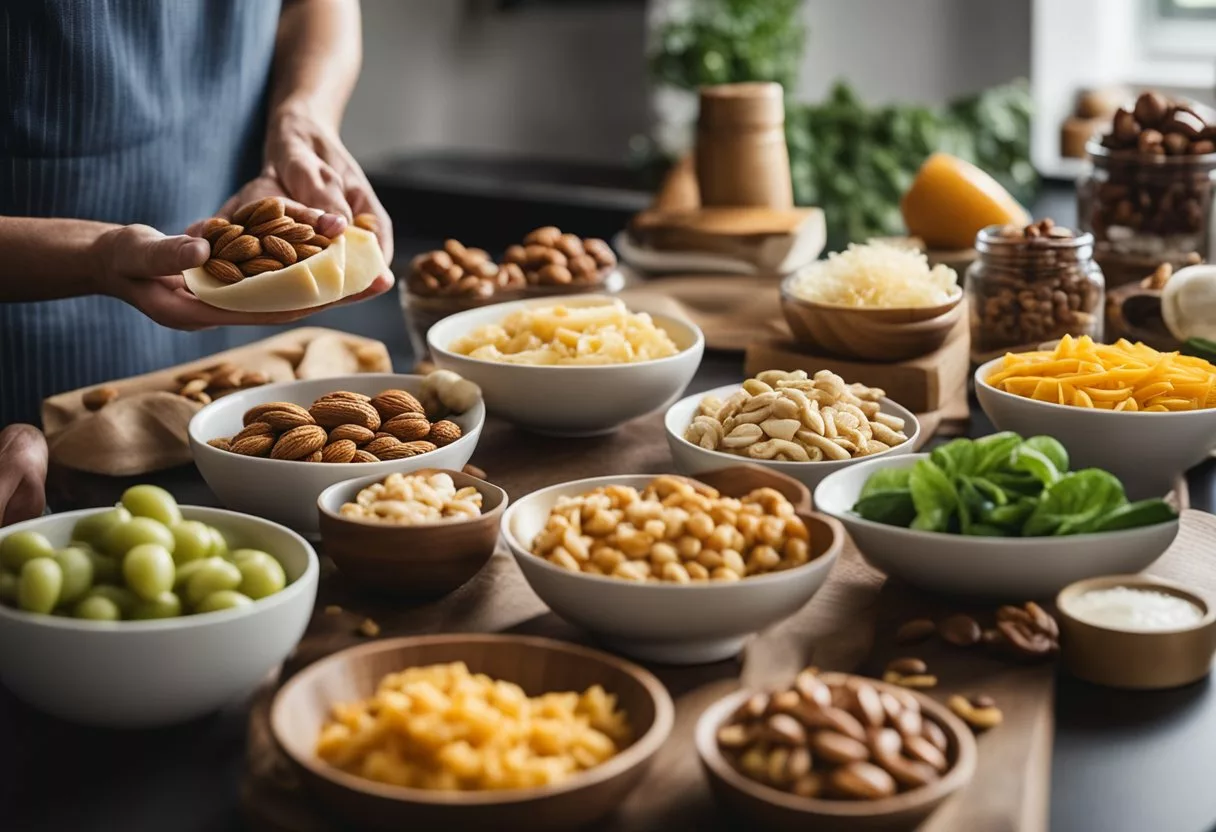
Embarking on a ketogenic diet often involves overcoming initial hurdles related to cravings and nutrition optimization. Here’s how individuals can navigate these challenges to maintain a healthy, low-carb lifestyle and achieve their weight loss goals.
Managing Cravings and Compliance
Cravings for sweet and creamy foods can be particularly challenging when trying to stick to a ketogenic diet. Individuals often struggle with the restrictive nature of the diet, leading to compliance issues. To manage these cravings:
- Preparation: Keep a stock of keto-friendly snacks that mimic the flavors and textures you crave. For instance, cheese or coconut cream-based desserts can satisfy a sweet tooth.
- Substitutions: Opt for low-carb alternatives like dark chocolate or berries when craving something sweet. Use sweeteners like stevia or erythritol to create keto-compliant desserts.
Dealing With Plateaus and Optimizing Nutrition
Individuals on a ketogenic diet may encounter weight loss plateaus or feel they are not getting enough nutrients. It’s essential to keep nutrition optimized and find ways to continue making progress:
- Variety in Diet: Ensure a varied selection of keto-friendly snacks and meals comprised of high-quality, nutrient-dense foods like avocados, nuts, and leafy greens.
- Adjusting Macros: If weight loss stalls, reassess and adjust macronutrient intake. This may involve increasing protein or reassessing fat intake to jumpstart metabolism.
